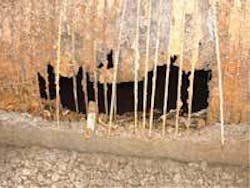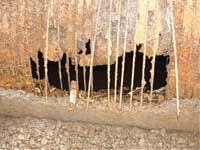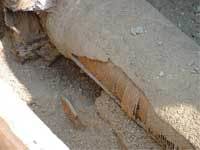Tablet System Neutralizes Hydrogen Sulfide in Force Main
The Town of Barrington, RI, has three lift stations which pump wastewater to the East Providence Wastewater Treatment Facility through a 24 inch force main. The Municipal Wastewater Authority experienced high levels of hydrogen sulfide resulting in the formation of corrosive acids in the main. The acids corroded the last 200 + feet of pipe leading to the plant, resulting in catastrophic failure. Measured atmospheric sample levels of H2S were reported between 200 to 400+ parts per million.
Barrington realized how important it was to reduce the hydrogen sulfide levels since the force main was designed to endure many years of service. Since the problem occurred in-route to the wastewater treatment facility, staff decided to treat the wastewater at the lift stations. The pump stations are located in residential areas approximately 100 feet from housing, so Barrington had to take into consideration a variety of factors: vandalism, security, aesthetics, noise, power and water consumption, equipment, chemical costs, construction and product delivery.
Staff investigated various systems to find the most efficient and practical solution to their problem. Their evaluation eliminated all but two solutions − Potassium Permanganate Control Release and Cellinite BioTabs − because the products are in solid form and do not require power, carry water, construction, dispensing equipment, etc. Barrington tried both products with success, but the Cellinite product was selected as the preferred solution since the tablets were simply tossed into the wet well while the potassium permanganate CR had to be placed in a netted bag and then submerged into the wet well.
BioTabs combine aerobic bacteria with oxygen, pH buffers, and nutrients to create an optimal environment for biodegradation. Once submerged in wastewater, the tablets begin to effervesce microfine oxygen bubbles. This oxygen action buries the tablet in the sediments at the bottom of the wastewater, while distributing the bacteria, oxygen, buffers and nutrients evenly through the environment. This “bottom-up” distribution means that tablets, unlike powders and liquids, need no additional treatment or servicing.
Using the tablets, the lift stations were treated with 9 lbs. per day at three locations within the system. The wastewater was tested for aqueous hydrogen sulfide levels and for atmospheric sulfuric acid at the end of the force main. Overall, the testing showed a 93.8% reduction of dissolved hydrogen sulfide and a 95.6% reduction of atmospheric sulfuric acid at the end of the force main. These results were logged after four days of treatment.
This was followed by two days of no treatment (weekend) and three days of a reduced dosage of 3 lbs. per day. During the reduced treatment, the hydrogen sulfide and sulfuric acid levels steadily increased to the previously untreated levels. On the fourth day, the recommended dosage was reinstated and the hydrogen sulfide levels dropped 82.4% and the sulfuric acid levels dropped 33.3% after one day of treatment. These results verified the reduction was in fact due to the addition of the Cellinite BioTabs.
In addition to the reduction of hydrogen sulfide and sulfuric acid levels, Barrington experienced a significant reduction in the solid grease and grease cap at its lift stations. Before using the tablets, the grease cap was a few inches thick. After two weeks of testing, the operators at the pump stations noticed the grease layer looked softer, like marshmallows. After continued use the grease overall was reduced by 95% to 99% and what was left of the grease cap was “little grease balls”.
Of the products considered and tested, Cellinite BioTabs were chosen for the estimated annual cost and for ease of handling.
The solid tablets require only gloves for handling; any broken pieces can be swept into the wet well. Other products, although solid, require proper dust masks, eye protection and gloves; when broken some products can leave a hazardous dust; and when wet or moistened will stain anything the product comes in contact with. No additional equipment is needed to apply the Cellinite BioTabs.
Barrington continues to use 3.5 lbs of Cellinite BioTabs per day at only one lift station located the furthest down the force main. Hydrogen sulfide levels have remained between 0 and 20 ppm. In addition, the program has resulted in a significant reduction in grease concentrations and odors in the system.
“We are very pleased with the [Cellinite] BioTabs,” said Anthony Silva, Department of Public Works.



